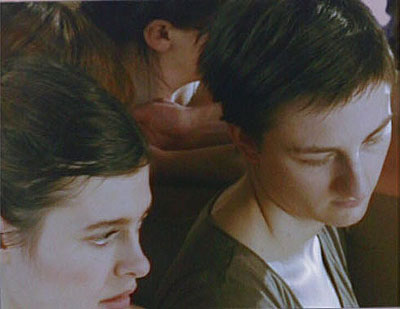
Victor Alimpiev »
The wind doesn't blow over the parquet
Exhibition: 13 Jul – 2 Sep 2006

Galerie Anita Beckers
Braubachstr. 9
60311 Frankfurt (Main)
+49 (0)69-92101972
info@galerie-beckers.de
www.galerie-beckers.de
Tue-Fri 11-18, Sat 12-17
In our videospace as well as our new project space SATELLIT in the center of Frankfurt we present videoworks of the Russian artist VICTOR ALIMPIEV in the exhibition "The wind doesn't blow over the parquet". In his videoworks VICTOR ALIMPIEV combines elements of diverse artistic genres like painting, theatre, dance and music in the moving image. The human "material" that seldom performs as individuals but mostly as a group of people in Alimpiev works, becomes a mouldable "mass" formed to a living sculpture, which reacts to its surrounding space. The movements of the mass in the space are defined by the repetition of monotone gestures, whose function seems familiar, but is subordinated to the dramaturgy of the moving image and are isolated from its context. "What is important is that the immobility of a sculpture is a tense immobility, the ‚eternal moment‘ of the sculpture – something slightly stretched, like trembling. For example, lyrical trembling, trembling before discomfort." (Alimpiev) The sound, be it in form of music oder the spoken word, has a decisive signification for the rhythm of this tense immobility. So in the work "Nightingale" (2005) the crowd of people seems to follow silent stage direction and therewith to abscond from the suck of Mahlers symphonie resounding out of the background. In "What is this place called?" (2006) it is the language, performed as a monotone sprechgesang and the significance of the word, which forms and places a group of 15 people in the space to a sculptural element. By encircling the group with the cameras and frozening single gestures in close-ups, there is achieved a level of merger of body and lanuage, which the theatre is denied because its impossibility of concurrency. Even in "Sommerlightning" (2004) image and movement undergo a symbiosis. School kids thump with their fingers on school banks or lay their hands – without the motivation getting apparent – with the palms opened on top of the table, to - little later - continue with the thumping. The menacing sound of the thumping is disrupted by the helpless gesture of the opened kids hands, so that the childish action seems to be a direct translation of the temper transmitted in the documentation of the natural phenomena of sommerlightnings which are superimposed to the video in irregular intervals. VICTOR ALIMPIEV "Der Wind bläst nicht am Parkett" Im Videospace der Galerie sowie in unserem Projektraum SATELLIT zeigen wir Videoarbeiten des russischen Künstlers VICTOR ALIMPIEV in der Ausstellung "Der Wind bäst nicht am Parkett". In VICTOR ALIMPIEVS Videoarbeiten verbinden sich Elemente aus unterschiedlichen künstlerischen Gattungen wie Malerei, Theater, Tanz und Musik im bewegten Bild. Das menschliche "Material", das selten als Individuum, sondern meist als Gruppe von Menschen in Alimpievs Arbeiten auftritt, wird als formbare "Masse" zur lebenden Skulptur, die sich zum sie umgebenden Raum verhält. Die Bewegung der Masse im Raum ist bestimmt durch die Wiederholung monotoner Gesten, deren Funktion bekannt scheint, die jedoch der Dramaturgie des bewegten Bildes untergeordnet und aus ihrem Kontext gelöst werden. "Wichtig ist, dass die Unbeweglichkeit der Skulptur eine angespannte Unbeweglichkeit ist; der "ewige Augenblick" der Skulptur hat etwas leicht Ausgedehntes, wie Erzittern. Zum Beispiel - das lyrische Erzittern, Erzittern vor Unbehagen." (Alimpiev) Der Ton, ob in Form von Musik oder gesprochenem Wort, hat entscheidende Bedeutung für die Rhythmisierung dieser "angespannten Unbeweglichkeit". So scheint in der Arbeit "Nachtigallchen" (2005) die Menschenmenge in ihrer Gestik lautlosen Regieanweisungen zu folgen und sich dadurch dem Sog der im Hintergrund ertönenden Mahlerschen Symphonie zu entziehen. In "Wie heißt dieser Platz" (2006) ist es die Sprache, vorgetragen in monotonem Sprechgesang, und die Bedeutung des Wortes, die eine Gruppe von 15 Personen im Raum als skulpturales Element formt und verortet. Die Einkreisung der Gruppe durch die Kameras und das Festfrieren einzelner Gesten in der Nahaufnahme wird hier ein Grad an Veschmelzung von Körper und Sprache erreicht, der durch den Verlust an Gleichzeitigkeit dem Theater versagt bleibt. Auch in "Wetterleuchten" (2004) gehen Bild und Bewegung eine Symbiose ein. Schulkinder trommeln mit den Fingern auf ihre Schulbänke oder legen, ohne dass die Motivation offensichtlich würde, die geöffneten Handflächen nach oben auf den Tisch, um kurze Zeit später mit dem Trommeln fortzufahren. Der bedrohliche Klang des Trommelns wird unterbrochen durch die hilflose Geste der geöffneten Kinderhände, so dass die kindliche Handlung eine direkte Übersetzung der in unregelmäßigen Abständen eingeblendeten Naturaufnahmen eines Wetterleuchtens zu sein scheint.


